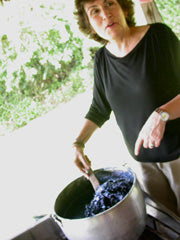OWP
Collares de rebanadas multicolores de Tagua- Teñidos a mano-Perú
Collares de rebanadas multicolores de Tagua- Teñidos a mano-Perú
No se pudo cargar la disponibilidad de retiro
Nuestras rodajas y cuentas multicolores de Tagua se tiñen con un tinte natural y luego se perforan y ensartan para hacer estos collares únicos. Son brillantes y atrevidos para hacerte destacar entre la multitud. También son ajustables para que puedas usarlos a cualquier largo. La gente preguntará de qué están hechos, de dónde vienen y quién los hizo. Puedes leer más sobre Tagua en la historia a continuación.
- Medida del collar: 20'' de largo x 1-1/2'' de ancho
- Ajustable
- Teñido a mano con tinte natural.
- Los pendientes a juego se venden por separado
La tagua, también conocida como marfil vegetal, es una semilla de una palmera en peligro de extinción que se encuentra en las selvas tropicales ubicadas a lo largo de la costa del Pacífico de América del Sur. Además de ser un recurso natural y renovable, la tagua comparte muchos rasgos similares al marfil de elefante, de ahí su nombre de marfil vegetal. Colombia ocupa el segundo lugar después de Ecuador en la producción y exportación de nueces de tagua.
Hecho a mano en Perú y comercio justo importado del Perú.
Le recomendamos que ayude a salvar los bosques tropicales considerando comprar nueces de Tagua. Lea nuestra descripción ampliada a continuación, en "Acerca de los artesanos" para obtener más información sobre cómo se hacen los tallados de nuez de tagua y cómo han ayudado a salvar miles de acres de selva tropical y hábitat de vida silvestre.
Share
About the Artisans
About the Artisans
 Joyeria Semilla meaning Seed Jewelry is a small fair-trade workshop in the Andean town of Villa de Leyva, Colombia. Girasol Taborda, a local artisan and social entrepreneur, started the workshop in the mid-1990s.
Joyeria Semilla meaning Seed Jewelry is a small fair-trade workshop in the Andean town of Villa de Leyva, Colombia. Girasol Taborda, a local artisan and social entrepreneur, started the workshop in the mid-1990s.
Joyeria Semilla’s objective is three-folds; to create new jobs, revive Colombia's handicrafts sector and to motivate locals to better manage their natural resources. The organization works primarily with socially and economically disadvantaged youths, single mothers and people with disabilities in the area. The company offers free training in product design, technical training and marketing to new members. Joyeria Semilla has trained them in the craft of jewelry-making.

Caña Flecha or “Gynerium Sagittatum” is a locally found palm tree in the regions of the Caribbean coast. The leaves from this plant are used for making jewelry, woven hats, bags and baskets. The Zenú Indians were and their descendants inherited the tradition of picking veins of the green palm leaf for weaving. These veins were made into woven hats and other products for their personal use.
The Zenú culture is said to have existed between 200BC to1600AD. With the arrival of the colonizers in the 16th century, the indigenous community declined of unknown reasons. Today a very small population remains that claims the inheritance of the almost extinct Zenú tribe. Known for their skills in the construction of major waterworks, canals and irrigation system along with being skilled goldsmiths, examples of their accomplished craftsmanship are found in various museums around the world. Their larger means of subsistence were hunting, farming, fishing and trading.
Caña Flecha is found in abundance in the region, and hence makes for a sustainable and naturally available raw material for these products. Every bit of the plant is utilized – from using in building walls and roofs in houses to food for cattle and medicinal purposes. It is from the central vein of the leaf that the fibers for weaving are obtained. After the hard surface is peeled off, the fibers are left in the sun to dry and undergo a natural tinting process; these fibers are barely about 1 millimeter in thickness and hence call for a lot of skill and patience to weave with. The dried fibers are then processed for natural coloration - some are boiled with lemon to whiten them and some are treated with mud and boiled with plantain leaves to blacken them. The designs are based on ancient motifs and mathematical representations, which are inspired by the early Zenú culture.


















